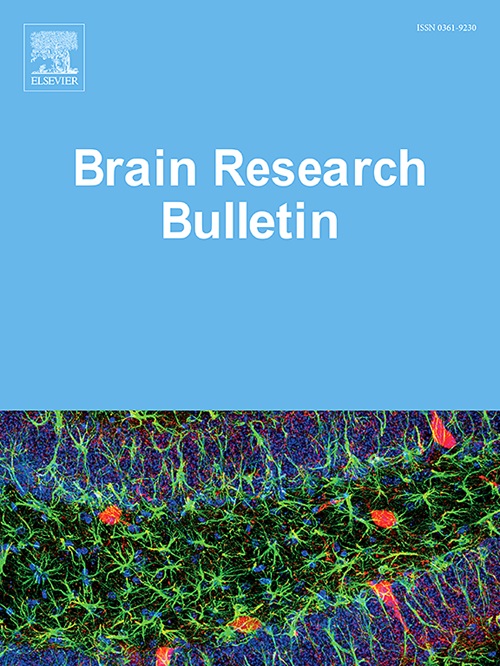Neural mechanisms of tinnitus: An exploration from the perspective of varying severity levels
IF 3.5
3区 医学
Q2 NEUROSCIENCES
引用次数: 0
Abstract
Objective
To compare the brain functional changes in tinnitus patients of varying severities, in order to elucidate the complex relationship between tinnitus symptoms and neural mechanisms, providing a basis for personalized treatment for tinnitus patients with varying severity levels.
Method
62 patients with chronic tinnitus were divided into severe and mild tinnitus group. 31 healthy controls (HC) matched for age, gender and education level were included. Resting-state functional magnetic resonance imaging was performed for all subjects, and the values of regional homogeneity (ReHo), amplitude of low-frequency fluctuation (ALFF), fractional ALFF (fALFF) and functional connectivity (FC) were calculated. One-way analysis of variance (ANOVA) was used to compare the differences among the three groups. Correlational analysis was conducted between imaging metrics and clinical information.
Results
Compared to the mild tinnitus, the severe tinnitus shows increased ReHo and ALFF values in the left superior temporal gyrus (STG), middle temporal gyrus (MTG), supramarginal gyrus (SMG), angular gyrus (ANG), and middle occipital gyrus (MOG), as well as increased ReHo values in the left superior frontal gyrus (SFG) and ALFF values in the right ANG. In the severe tinnitus group, the FC between the bilateral ANG and the left MTG, the right ANG and the right medial SFG, the right ANG and the right anterior cingulate gyrus (ACG), as well as between the left SFG and the left rectus gyrus, was increased compared to the mild tinnitus group. In mild tinnitus group, the ReHo of left STG is correlated with tinnitus severity by Tinnitus Handicap Inventory.
Conclusion
Patients with different severity of tinnitus exhibit different compensatory mechanisms in brain function, highlighting the need for stratified analysis based on severity when investigating the underlying neural mechanisms.
耳鸣的神经机制:从不同程度的角度探讨。
目的:比较不同严重程度耳鸣患者的脑功能变化,以阐明耳鸣症状与神经机制的复杂关系,为不同严重程度耳鸣患者的个性化治疗提供依据。方法:62例慢性耳鸣患者分为重度耳鸣组和轻度耳鸣组。纳入年龄、性别、教育程度相匹配的健康对照(HC) 31例。对所有受试者进行静息状态功能磁共振成像,计算区域均匀性(ReHo)、低频波动幅度(ALFF)、分数ALFF (fALFF)和功能连通性(FC)的值。采用单因素方差分析(ANOVA)比较三组间的差异。对影像学指标与临床信息进行相关性分析。结果:与轻度耳鸣相比,重度耳鸣表现为左侧颞上回(STG)、颞中回(MTG)、边缘上回(SMG)、角回(ANG)和枕中回(MOG)的ReHo和ALFF值升高,左侧额上回(SFG)的ReHo和ALFF值升高,右侧额上回的ALFF值升高。重度耳鸣组双侧ANG与左侧MTG、右侧ANG与右侧内侧SFG、右侧ANG与右侧前扣带回(ACG)、左侧SFG与左侧直回之间的FC均较轻度耳鸣组增加。轻度耳鸣组左STG ReHo与耳鸣严重程度有相关性。结论:不同耳鸣严重程度的患者在脑功能代偿机制上表现出不同的特点,在探讨其潜在的神经机制时,需要根据耳鸣严重程度进行分层分析。
本文章由计算机程序翻译,如有差异,请以英文原文为准。
求助全文
约1分钟内获得全文
求助全文
来源期刊

Brain Research Bulletin
医学-神经科学
CiteScore
6.90
自引率
2.60%
发文量
253
审稿时长
67 days
期刊介绍:
The Brain Research Bulletin (BRB) aims to publish novel work that advances our knowledge of molecular and cellular mechanisms that underlie neural network properties associated with behavior, cognition and other brain functions during neurodevelopment and in the adult. Although clinical research is out of the Journal''s scope, the BRB also aims to publish translation research that provides insight into biological mechanisms and processes associated with neurodegeneration mechanisms, neurological diseases and neuropsychiatric disorders. The Journal is especially interested in research using novel methodologies, such as optogenetics, multielectrode array recordings and life imaging in wild-type and genetically-modified animal models, with the goal to advance our understanding of how neurons, glia and networks function in vivo.
 求助内容:
求助内容: 应助结果提醒方式:
应助结果提醒方式:


